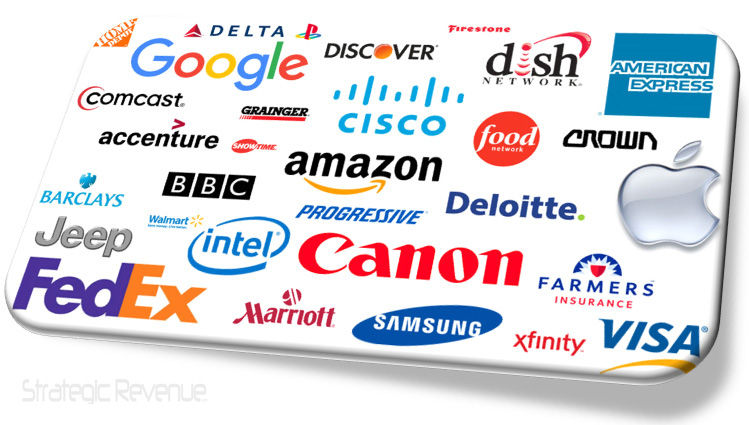NEW YORK, NY – Regardless of what your position is on new gTLD domains “Big Brands” are buying in hook, line and sinker while ICANN is raking in hundreds of millions of dollars on new gTLD fees. Each new application cost its applicant $185,000.00 and with it, an annual maintenance fee of $24,000.00 (yearly recurring).

This doesn’t include potentially hundreds of generic domains that were applied for and went to auction (I didn’t count each one [Full statistics here] 357.05 million US$ in just application fees). I wanted to look at the “Big Brands” to measure use and adaptation. And these application and registration fees did not limit ICANN’s ability to generate additional revenue; there was also public auctions for competing applications. For instance, Google paid $25,000,001 for the domain .app while Amazon bought .buy for $4,588,888. According to Phil Buckingham in Circle ID, ICANN public auctions proceeds were disclosed (sometime around 2015) shedding light onto the high dollar amount of these auctions.
In this list below, I took a look at how many large established and reputable brands have applied for their trademarks in domain extensions and there is about 500 of them here. This does not include many generic vanity type applications; most of those I did not even include (aside from a few on the second notable list below) as I wanted to get a feel for what the major corporate players see in these new URLs and how they are reacting to the opportunity to own and maintain their own dots; It’s about (roughly) 4% actually switch over their main corporate sites to .branded URLs – just 4%.
This is because the majority of these registrations are likely just proactive and defensive efforts at protection of their trademarks through advisory services such as Brandshield.com, FairWindsPartners.com, and MarkMonitor.com (these gTLD consulting companies must love all of this). Trademark owners are actually obligated to protect their mark from infringement, no-matter how insignificant that infringement might seem; failing to do so weakens the marks significance as an identifier of goods and/or services from a particular source, and can result in rights being lost.
Below is a list of major worldwide corporations who are acting on gTLDs regardless of what their intent might be. Brands which have begun using the new extension as their primary corporate websites have their gTLD on the left BOLD. There are only a handful of them here.
Additional notable gTLD applications are listed below for companies which are claiming keywords and generic terms that fit well within their portfolio of services or otherwise make a good fit for who they are in the business world and what they are trying to accomplish as a brand.
For the most part, these are not registries such as Donuts Inc. or Uniregistry Inc looking to sell domain names for registration fees (both have certainly acquired plenty of fantastic strings). These are companies willing to run the extension and/or hold onto it for their own branded use.
Looking at all of these innovative and amazing companies above we can see the hundreds of millions being spent on these new domain addresses in addition to the hundreds of millions which will likely continue to add up further in new applications (round two), maintenance fees and registrations down the road. It can’t just all evaporate.
Some domainers love these new gTLDs while some absolutely hate them, but whatever side of the fence you’re on there is little to dispute when its all listed above – a great deal of very smart minds are investing heavily in this new digital era. Google, for instance, one of the worlds most innovative and forward thinking companies on the planet spent 25 Million on just one of these (.app), for what? Let’s take this list of domains above and use it to tell us what is happening in the next frontier.
What’s here that we do not yet see or understand that clearly? Will time tell, or is the future being gobbled up around us by the second. Do we just see-right-through some of the greatest minds in the world, behind these most successful businesses above in the list? Is it Protection….? Innovation….? What say you?

About The Author: John Colascione is Chief Executive Officer of Internet Marketing Services Inc. He specializes in Website Monetization, is a Google AdWords Certified Professional, authored a ‘how to’ book called ”Mastering Your Website‘, and is a key player in several Internet related businesses through his search engine strategy brand Searchen Networks®

 *** Here Is A List Of Some Of The Best Domain Name Resources Available ***
*** Here Is A List Of Some Of The Best Domain Name Resources Available ***
It is a bunch of defensive registrations. None of those companies are doing anything of substance with their .brand’s.
For the small % who did anything at all most have backtracked on their “big plans”, e.g. barclays, canon and bmw.
The .brand’s have done far worse than the rest of the ntld pool.
But this is where the majority of money is going, as far as ICANN is concerned.
Registries keep the majority of the individual domain registration fees.
The .brands seems like where the money is for ICANN. At least I think.
When you have billions …spending millions ain’t impressive.
I guess so; chump change for lucky brands.
It is an impressive list of words, interesting to see which companies are protecting which words. ie: shows what’s important to them. Many of the words could actually apply to many different companies, for example Google has .docs, but it could easily have been Microsoft. L’Oreal protecting .beauty and .makeup, but there are lots of other similar companies in the beauty industry.
Yea, that was why I included that second list. Although there is some really good dots owned by registries, there were some really clever land-grabbers I thought looked like they were worth mentioning as they were grabbed not for resale but to corner the market for those companies. Just felt they deserved mention.
So what is ICANN doing with all the money? They could wipe-out some third world debt with what they’re making selling something which costs virtually nothing to produce.
@Linden
And that is a very good question. Buckingham brought up this same question in his CircleID article. As a non-profit, where is all this money going?
Also how does ICAAN get to sell trademark names back to their owners? You can’t register a domain name with a trademark in it, but ICAAN takes the trademark and sells it back as a domain extension?
Well, the trademark is not really created after the dot until it is requested to be created by the company first ordering it. I guess it is more of an open-ended threat, that says, Hey, you better create one for yourself while you have the opportunity and before someone else does that might look or be confusingly similar to yours or something you would have wanted. Like the equivalent of erecting a giant sign over Manhattan and saying I’m going to let anyone create a giant sign with anything they want on it, until each sign is taken and if someone chooses to erect one with something that looks sort of like your name on it, that is going to be fine by me, you’ll just have to explore what to do about it at that time because once a sign is erected, no one else will be able to have a sign with that name or word on it, and I don’t care who is asking for it. So the big brands just figure it easier and cheaper to just register it now while they have the chance to instead of waiting till later when they decide they should have done so sooner or then having to figuring out how to litigate it in the event that becomes necessary. This is just an assumption of course, but 96% of them are just sitting not being used, so certainly seems like some sort of defensive mechanism. I’d bet reading into a bunch of gTLD protection and consultation company websites would lead into more on the whole they’re applying and not using.
Crazy stuff. You’d imagine that if somebody who was not the trademark owner tried to get the trademarked (or very similar) extension it would be treated like a trademark infringement and subject to UDPR, in the same way a domain name would be.
Add up all those trademarks and the money they’ve spent to get what would rightfully be theirs if challenged in court, and it makes you wonder why none of the big corporations waited to test it, if and when it happened.
When things like this don’t make sense, someone, somewhere is usually making a truckload of cash.
There is probably a process or deterrent system in place for trying to claim a mark in a tld but honestly I am unsure of that might be, if one even exists. There is the Trademark Clearinghouse for single registrations, but I do not know if there is one on the application side for the registry creation itself.
I reckon if you were Apple or Google and somebody took your extension they’d soon feel the full weight of the legal process bearing down on them.
From a legal standpoint when shifts occur in society or commerce then new legal challenges arise. The domain space is relatively new and the registration of trademark domains was something which was unforeseen prior to the web.
It would be impossible to believe that 1. ICAAN would sell the right to a trademark; as they would then potentially leave themselves wide open to a lawsuit from the likes of Amazon. 2. If they did, the giant companies would let the buyer/and or ICAAN go unchallenged.
You only need one landmark case to set a precedent in law and nobody would win if a big corporation took them on.
So, I find this situation very interesting and quite puzzling.
(I don’t expect you to print this. I’m just thinking out-loud in response to your reply). I will watch this space with great interest.
Talking about the TLDs it reminds me a story of Mark Zuckerberg when he had to pay $700 to an Indian boy to purchase a domain for his Daughter Max. Zuckerberg. This clearly shows the importance of TLDs for a brand and how it becomes the identity of the brand. Even Facebook paid $8 Billion to acquire Fb.com,
Hey nice blog…thanks for sharing